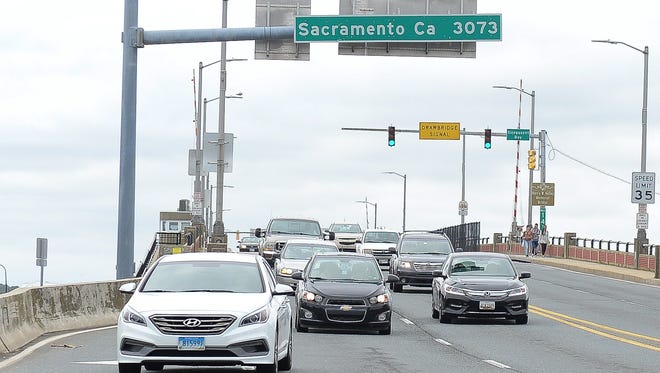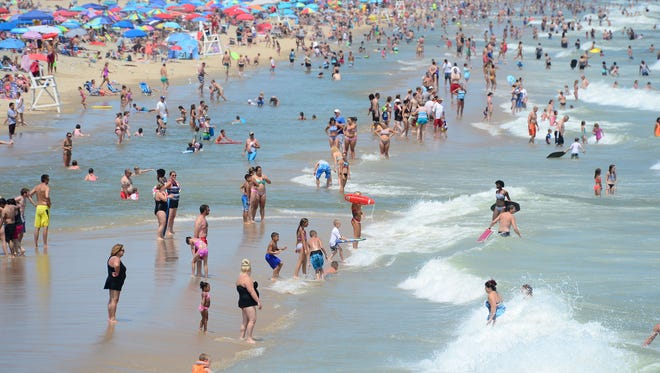Ocean City: Can the tourism bustle grow?
The rumble and exhaust from the motorcycles have ceased.
It's the yearly reminder for residents of what season it is in Ocean City. The umbrellas that dot the beach are sparse. The nightly wait for a table at a restaurant isn't as daunting, nor are the lines at the resort's many amusement parks, mini-golf courses and night clubs.
The locals' summer is here, and the sun is still shining.
The offseason is historically a time of refurbishment and reflection, and after this past season’s robust numbers, the central question buzzing around the resort is: Has the tourism industry reached its ceiling?
That shoulder tourist season is the time of the year that Philip Zelson enjoys most at his Montego Bay home in north Ocean City. It's April and May and September and October that make it home for him.

“The offseason is what my wife and I live for," he said. "We suffer through the busy season so we can enjoy the peace of the rest of the year.”
But while Zelson and many of his fellow 7,000 year-round residents emerge during the offseason, town officials and business owners have their sights set on making Maryland's second largest city in the summer even more profitable.
READ MORE: Delaware dune breach, flooding raise worries about what a big storm would bring
READ MORE: Sunfest music continues through the weekend in Ocean City

Because without all the traffic, tourists and taxes, Ocean City wouldn't be Ocean City.
"If we were a little sleepy beach town, would we have all the amenities we have?" asked Mary Knight, town councilwoman and chair of the tourist commission. "Would we have all the fine dining, the free activities?"
It's one of the many arguments in a seesaw battle over what type of town Ocean City should be.
The 300,000 visitors who flock to the 4.4 square-mile town on any summer day provide tax dollars that are pumped back into state, county and town governments.
In June alone, Ocean City raked in just shy of $9.9 million in tourism taxes, according to the monthly metrics report. Those dollars have been on an uptick since the downturn of the Great Recession and are expanding into the shoulder season. The traditional summer tourist season runs from Memorial Day to Labor Day, while the town has added events and other draws to expand tourism to March through May, as well as September and October.
In May, $5.3 million entered the town coffers.
And there's still space in hotels and motels during the June to August rush, officials say.

Brooks Trimper, operations manager at Trimper Rides and Amusements, has worked since he could stand and count money. The family business is the oldest family-owned amusement park in the country and the second oldest in the world, according to Jim Futrell at the National Amusement Park Historical Association.
Trimper has seen Ocean City busier throughout the years and thinks there's the potential for more — something most of the town's numerous owners crave.
“You used to drive through the town and there’d be no-vacancy signs everywhere," he said. "Now, other than on Saturdays, there are no bad traffic days. I know the town, and certainly my business can handle more people coming in."
READ MORE: Trimper's Rides is an Ocean City legend at 125 years
Knight and the town's leadership also think the town can accommodate more people, during both the summer and the shoulder seasons.
Trisha Parks, 22, of Philadelphia agrees with Knight. She said she lives for the crowds; for the long lines, packed Boardwalk and flooded nightlife destinations.
“If you have to wait for something, it helps make you aware of just how worth it it’ll be,” she said. “A big reason we come down here is for the parties, and what’s the point of visiting an empty club?”
Those viewpoints are not popular with many locals, however.
Zelson said he's already at a breaking point.
“Can you imagine this place bigger than it already is on a day like the Fourth of July?” he said. “If it gets any crazier, I’d get out of town a few days earlier and leave the place to the tourists.”
Added Zelson: “It’d be absolutely outrageous. I don’t see how we’d live with it.”

Full capacity
For the town's iconic destinations, the worry about filling up on a weekend isn't an issue during summer nights.
Filling the house is rarely a problem at Fager's Island, said Kevin Myers, general manager of the Ocean City restaurant and bar. After 40-plus years, it has a reputation that keeps seats filled.
“By virtue of how long we’ve been here and how much we offer, things are easier on us,” he said. “On Saturdays, we couldn’t be any busier, and we’re filled up in almost every sense during the height of the season.”
But Myers welcomes more visitors in town. More beachgoers means better business for all establishments.
Business owners know creativity, quality service and location will bring locals and tourists back to their establishments.
“People drive by, come in, have a drink with us, and even if they can’t stay for dinner or anything else, it’s still fantastic,” Myers said.
But a location on the bay like Fager's is hard to come by in the jam-packed town.
Because of a lack of undeveloped real estate, developers have found other ways to make room for those headed east across the Bay Bridge.
Older and smaller accommodations have been razed, and grand skyscraping hotels have taken their place.
It's a trend that is similar to Las Vegas, which is restricted by federal borders instead of the ocean and bay that surrounds Ocean City, according to Clifford Rossi, a professor of finance at the University of Maryland, who spent nearly 25 years in the banking sector before moving to the Eastern Shore.
There were serious questions about Vegas' growth in the early 2000s because of the federal government owning the surrounding land, but Rossi said that city still experienced yearly growth on both the commercial and residential side.
Rossi did not suggest that Ocean City was on the eve of another boom in growth, but that steady expansion is certainly possible.
"When the question is asked about whether growth is still possible in a locationally constrained place like Ocean City, there are always possibilities if the economic conditions are there," he said. "And those conditions are fairly strong for the town right now."
The rebuilding of Ocean City is something Mayor Rick Meehan says is a goal of the town.
"We've been very fortunate in Ocean City to rebuild our city over the last 20 years to maintain that new look and to replace older buildings," Meehan said, adding that the newer building have features "today's visitors are looking for."
The town is also in the process of updating its comprehensive plan due to population growth and shifting trends in housing and tourism.
The Crystal Beach Hotel on 26th Street is set to add 63 units. The Commander Hotel on 14th Street just finished $5 million in renovations this spring.
A few blocks north on the bay, on 25th Street, the Fairfield Inn & Suites replaced the Misty Harbor Hotel in 2017. The Hyatt Place Hotel on the Boardwalk at 16th Street will replace Sea Scape Motel by spring 2018.
And by the end of the winter, a 150-room Residence Inn run by Marriott will greet visitors as they enter town from the Route 90 bridge.
READ MORE: Denny's will take the place of J/R's on 62nd Street
Yet for Susan Jones, director of the Ocean City Hotel-Motel-Restaurant Association, the challenge is to fill all the nearly 10,000 rooms available and 25,000 rentable condo units for Ocean City to continue to grow.
According to the most recent metrics report, June saw an average occupancy of lodging townwide at 76.5 percent. One month prior, it was 61.4 percent.
"We have plenty of businesses, what we need to do is increase the demand for visitors though, because we aren’t operating at full capacity for the most part," she said.

Calm versus crowds
Despite the earnest welcome from town officials and businesses, the debate of what is best for Ocean City continues.
The answer depends on who is asked.
Mary Welch doesn’t live in Ocean City but said she might as well, having vacationed in the town for more than 50 summers.
“Tourists are not welcome, and I don’t even live here,” she said. “Look, I’ve been coming here forever. You look at all these high rises, all these huge hotels, and they’re just taking your view away and crowding the streets.
“It’s horrible, and I can’t imagine anyone wanting more of that."
Welch grasps the irony of her stance on tourists coupled with her status as one, but insists on it just the same. She said she isn't confident that the town's roadways and general infrastructure are up to the task of more people.
“I get that this is the pot calling the kettle black,” she said. “I really do, but seeing the town get larger and larger, as good as it might be for the economy, is just ruining Ocean City.”
Just as the hotels, restaurants and entertainment venues have kept up to date to keep tourists coming back, Meehan said the town has done the same with the infrastructure.
Adequate facilities like wastewater treatment, sound roadways and other services had long been a priority prior to Meehan's 11-year reign as mayor.
Valued attractions, such as the Roland E. Powell Convention Center, have also undergone updates throughout the years.
In 1970, it boasted 40,000 square feet of exhibit space and seven meeting rooms. Through a string of improvements between 1997 and 2014, it now offers 60,000 square feet of exhibit space, 19,126 square feet of ballroom space, 23,295 square feet of meeting space and a 1,200 seat Performing Arts Center.
These continual improvements have prepared Ocean City for the future, Meehan said.
“We’ve maintained our roadways and continue to repave and rebuild our streets,” he said. “We understand that as more people do come to visit or retire and live here, we have that infrastructure in place.
“So I think we’re in a very good position to handle anything that comes our way."
Jason McKenzie, 23, of Philadelphia is a regular visitor who unknowingly allied himself with the mayor. He’s been coming to town once or twice a year, every summer, for several years now.
And he loves nothing more than the crowds.
“I live for the crowd,” McKenzie said. “There’s something about being part of a huge mass of people — in clubs, in the water or on the Boardwalk — that’s just fun. The more people the better.”
McKenzie said traffic congestion and long lines are just “the cost of doing business” and having fun in Ocean City, and being packed in with other visitors is what makes the town what it is.
“I don’t mind if it takes me a little longer to get from one point to another, or if I have to find someplace else to eat or wait to get into a club,” he said.
On Twitter @ReedAShelton